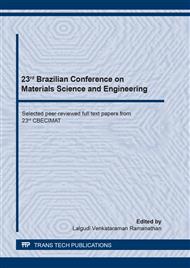p.207
p.215
p.221
p.227
p.233
p.239
p.244
p.250
p.256
Use of Ceramic Waste for the Manufacture of Sintered Parts
Abstract:
This paper evaluated the use of the pitcher, a ceramic waste obtained through the quality process of a sanitary ware industry, in the development of a material for usage in the manufacture of sintered parts. The pitcher was obtained through powder technology and is composed, according to the chemical analysis obtained by X-ray fluorescence spectrometry, of clayey minerals (clay and kaolin), quartz, and feldspar, which may include ceramic rocks such as granite, pegmatite and phyllite; that is, it has proved to be a potential raw material due to the minerals that can still be reused. The pitcher passed through a granulometry-based selection process, sieving about 20kg using the following sieve sequence: 18 MESH, 25 MESH, 30 MESH, 120 MESH and 400 MESH; with around 70% of the residue being retained in the sieves of 120 and 400 MESH, which were selected to be used in the evaluation. The samples were compacted in a manual press with different pressures, between 300 and 1000 kgf, and after were sintered at a temperature of 1100oC in a resistive furnace. To characterize the material, the apparent and green density, as well as the compressibility curve, were determined to identify the best compression pressure. The microstructure of the test specimen and the pitcher homogeneity were evaluated using Scanning Electron Microscopy (SEM). Both particle sizes presented the typical compressibility curve, in which the density increases with increasing compaction pressure, while the curve slope decreases with increasing pressure. The density increase with the increasing compaction pressure indicates a good densification for the temperatures, independent of the sample granulometry. The sintering porosity decreased proportionally to the particle size in the sintered samples. The analysis showed that the particle size of 400 MESH sintered at 1100oC obtained more porous surfaces, thus indicating a promising future for the manufacture of parts using powder technology, especially for the development of filters.
Info:
Periodical:
Pages:
233-238
Citation:
Online since:
October 2020
Keywords:
Price:
Сopyright:
© 2020 Trans Tech Publications Ltd. All Rights Reserved
Share:
Citation:


